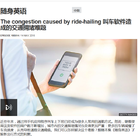
叫车软件造成的交通拥堵难题
介绍: Vocabulary: traffic and transport 词汇: 交通运输
Have you ever taken a taxi? In the past, doing so meant finding one, flagging it down and telling the driver where you wanted to go, paying, and possibly, adding a tip. And while this still happens, it’s less common than it used to be. These days, it’s much e...
介绍: Vocabulary: traffic and transport 词汇: 交通运输
Have you ever taken a taxi? In the past, doing so meant finding one, flagging it down and telling the driver where you wanted to go, paying, and possibly, adding a tip. And while this still happens, it’s less common than it used to be. These days, it’s much easier to open a ride-hailing app. All of the boring stuff gets taken care of. It’s a perfect solution!
Except that it isn’t. A recent report from urban transport consultant Bruce Schaller, who spent the last four years studying traffic flow in New York, concluded that the use of these app-based journeys is causing traffic jams. The 81% increase in these city-based rides means that there are now five times more of them than the iconic yellow taxicab.
“It’s the shift in patronage from public transport,” he told the BBC. For whatever reason, people decide that it’s just too much hassle. “That means moving people from larger vehicles into smaller ones, which means more vehicles to move the same people. Therefore, more traffic.” In addition, the sheer number of cars now looking for a commuter means that they spend 45% of their time empty, just cruising for a fare, and inadvertently clogging up the city’s infrastructure.
“They are out there in force at the worst possible times,” said Prof Christo Wilson, a computer scientist at Northeastern University, who has also studied the services. He refers to Uber’s traffic data, which ‘perfectly matches the peaks for the rush hour.’ He also adds that the low fares and convenience mean that people are ordering rides to go from A to B when they wouldn’t normally. Both help contribute to the gridlock.
So what can be done to stop traffic from backing up or bottlenecking? One solution involves combining ride-hailing with sharing. Many ride-hailing companies, such as Uber, Didi Chuxing in China and Ola in India enable customers to carpool. This allows travellers who share similar destinations to share the journey. The app enables an en route pickup,which means more streamlined traffic, and less time spent with an empty vehicle.
Could this decongest the world’s jam-packed roads? It is certainly one solution. But maybe we shouldn’t be so quick to dismiss the more traditional public transport options. "Congestion is a really complicated issue," said Andrew Salzberg, head of Uber's transport policy. But, “There is no more efficient way to move people around than public transport," he added. So don’t do away with that bus pass just yet.




